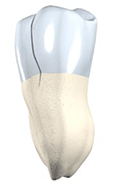
At the center of each of your teeth is a hollow space occupied by nerve and blood vessel tissue called the dental pulp. This dental tissue was essential to the tooth while forming, providing sustenance to the developing tooth. Once the tooth has matured, the pulp is not necessary for a functioning tooth.
SOURCES OF TOOTH DAMAGE
If a tooth is subjected to trauma, damage can occur to the pulp. The sources of injury include the following:
-
Severe tooth decay.
-
Physical impact o the tooth or its supporting bone. The tooth may be fractured or broken. Even if the tooth is not visibly damaged, the trauma shock is often enough to injure the pulp. Some cracked teeth are repairable, and other types of cracks and splits are not.
-
Severe wear of tooth surface through attrition, abrasion, or erosion.
-
Advanced periodontal disease.
Severely damaged pulp will die. The dead cells provide what is commonly called a pulpal abscess. Often it will be accompanied by pain. A damaged pulp can also be sensitive or painful. Discomfort is not always immediate, and symptoms differ for a live injured pulp or dead pulp. Information you provide us in conjunction with an examination and x-ray will provide the diagnosis in most cases.
Except when a fracture of the affected tooth makes it unrestorable, your dentist can save many injured teeth potentially for the rest of your life. To do this, the damaged pulp is removed from the tooth in endodontics or root canal therapy. When deemed necessary to preserve a tooth, a root canal procedure can accomplish this with little or no discomfort.
ROOT CANAL THERAPY
To treat a tooth with root canal therapy, a hole is made in the tooth’s center to allow the dentist access to the damaged pulp. Small instruments, called files, and a solution to dissolve tissue are used through this access cavity to clean out the pulpal tissue that could nourish germs. Once the pulp has been removed to the root’s tip, the space previously occupied by the pulp is filled with cement, an inert material designed to prevent germs from accessing the tooth, which could cause future infection. Sometimes, a root canal may carry out these steps in a single office visit. Often, though, two, three, or more visits are required.
FEES FOR ROOT CANAL
The number of roots in the tooth determines fees for a root canal. This fee only covers root canal therapy and does not cover the cost of restoring the tooth. The visible part of the tooth is called a dental crown.
RESTORING THE TOOTH
Endodontically treated teeth all need to be restored following treatment. In some instances, this will be limited to a bonded filling in the access cavity. Often, the damaged tooth will require an inlay or crown to restore it to normal appearance and function. The American Dental Association recommends that all endodontically treated back teeth be protected with a crown or inlay because of the high fracture incidence. Tooth restoration is a separate and distinct portion of treatment from the endodontic therapy provided.

Chandler Cosmetic Dentist
Kelly Jorn Cook, DDS
3800 West Ray Road, Ste 19
Chandler, AZ 85226
Phone: (480) 899-4477
https://www.kellyjorncook.com